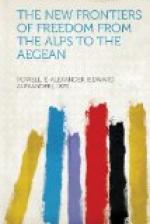"Beside the ruins
of Troy they lie buried, those men so beautiful;
there they have their
burial-place, hidden in an enemy’s land!"
We got under way at daybreak and, picking our way as cautiously as a small boy who is trying to get out of the house at night without awakening his family, we crept warily through the vast mine-field which was laid across the entrance to the Dardanelles, past Sed-ul-Bahr, whose sandy beach is littered with the rusting skeletons of both Allied and Turkish warships and transports; past Kalid Bahr, where the high bluffs are dotted with the ruins of Turkish forts destroyed by the shell-fire of the British dreadnaughts on the other side of the peninsula and with the remains of other forts which were destroyed in the Crusaders’ times; past Chanak, where the steep hill-slopes behind the town were white with British tents, and so into the safe waters of the Marmora Sea. Though I was perfectly familiar with the topography of the Gallipoli Peninsula, as well as with the possibilities of modern naval guns, I was astonished at the evidences, which we saw along the shore for miles, of the extraordinary accuracy of the fire of the British fleet. Virtually all the forts defending the Dardanelles were bombarded by indirect fire, remember, the whole width of the peninsula separating them from the fleet. To get a mental picture of the situation you must imagine warships lying in the East River firing over Manhattan Island in an attempt to reduce fortifications on the Hudson. Men who were in the Gallipoli forts during the bombardment told me that, though they were prevented by the rocky ridge which forms the spine of the peninsula from seeing the British warships, and though, for the same reason, the gunners on the ships could not see the forts, the great steel calling-cards of the British Empire came falling out of nowhere as regularly and with as deadly precision as though they were being fired at point-blank range.




